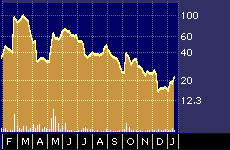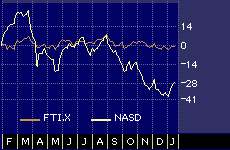
Can Stock Valuations Grow?
Can Stock Valuations Grow?
By Hal Plotkin
CNBC.com Silicon Valley Correspondent
Jan 23, 2001 06:22 PM
If the stock market is overvalued, even good stocks are likely to go down. But if the market is fairly valued or undervalued, the most-successful companies will see their stock prices rise from current levels.
This is an important question because if stocks are overvalued in general, then there is no amount of company-specific research that can protect investors from near-certain losses.
On the other hand, if stocks, on average, are reasonably valued as an investment vehicle, then good news about individual company earnings and growth rates should translate into price appreciation for those stocks.
So which is it?
I thought my old friend Alan Lertzman might know.
Lertzman, now retired, was one of Silicon Valley’s leading stockbrokers and financial commentators back when I cut my teeth reporting on technology stocks in the late 1970s. The veteran money manager started his career at Sutro Investments in the mid-1950s. At the time, the Dow Jones Industrial Average, now above 10,000, was at about 500.
One of Lertzman’s first stock picks in 1958 was Fairchild Camera, which had just come up with something the company’s engineers were calling a semiconductor. Members of Fairchild Camera’s engineering and marketing teams would later go on to found many of Silicon Valley’s leading companies, including Advanced Micro Devices Inc. {AMD}, Intel Corp. {INTC} and National Semiconductor Corp. {NSM}.
“We’ve seen bubbles come and go before,” Lertzman says. “This wasn’t the first time, and it won’t be the last.”
Lertzman says he remains confident, however, about the overall long-term upward trajectory of the stock market, despite the incredibly rapid rise in the leading indexes, most notably the Dow industrials, over the past eight years.
Someone who has seen the Dow 30 rise from 500 to more than 10,000 might, you would think, be a tad worried about the possibility of a sharp decline. But Lertzman says he doesn’t see it in the cards.
Given his personal experience, Lertzman says that rather than a sharp and lasting decline we are far more likely to see the Dow hit 40,000 by the end of the next decade as Charles Moore recently predicted in his attention-grabbing book, Dow 40,000: Strategies for Profiting from the Greatest Bull Market in History.
Like Moore, as Lertzman sees it, we only need about 10% annual compound growth in equities over the next decade to bring a 30,000 Dow within easy reach. We do a little better, and Dow 40,000 isn’t out of the question, he reasons.
During the last 30 years, for example, the average annual return of the total U.S. stock market was about 13%.
What is more, Lertzman doesn’t see any reason the next decade will be any less exciting, or any less rewarding, than the average performance posted over the five decades he spent actively managing investor portfolios.
“40,000 sounds like a big number,” Lertzman says. “But it’s all relative. Back when we were at 500 in the Dow, 10,000 seemed like a big number, too.”
That doesn’t mean that Lertzman expects the growth will take place in a straight and stable line, because it rarely if ever has. But the longer your time frame, he says, the better your chances.
One question, however, is whether the overall market can rise to those levels without pushing average price-to-earnings ratios into unsustainable nosebleed territory.
In early 2000, for example, the U.S. stock market briefly traded at almost 40 times profits, or about three times the average from 1946 to 1996.
More recently, however, the Standard & Poor’s 500-stock index has fallen back to about 21, based on estimated earnings in 2001.
That compares favorably with the major European indexes, which have recently traded in the high teens to mid-20s in average P/E ratios. The one exception: Japan where, despite the decade-long business slump, the average P/E ratio for stocks listed on the first section of the Tokyo Stock Exchange was nearly 52, based on closing prices at the end of December.
The bigger question now, however, is whether U.S. corporate earnings will continue to accelerate to the degree needed to push the overall market to at least annual low-double digit returns over the next decade or so.

One-year performance of Echelon Corp. {ELON}
Lertzman is betting it will, but he says the best strategy is to look for what he has always looked for: companies that are doubling their earnings every one to two years, and be willing to pay somewhere between 40 to 50 times earnings for those stocks.
That probably leaves out companies such as Cisco Systems Inc. {CSCO}, given the law of large numbers that make that kind of continued earnings acceleration less likely.
But it leaves in, Lertzman says, companies like Echelon Corp. {ELON}, which are pioneering new technology applications in industries that are just beginning their growth curves. (Echelon’s technology focuses on home-automation systems).
CNBC.com: Echelon Triples on Investor Enthusiasm
Echelon’s stock got clobbered recently along with the rest of the tech sector. But Lertzman says the money will find its way back into U.S. growth-company stocks such as Echelon if those companies continue to increase revenue and profits at a fast clip.
“Where else are investors going to go with their money?” asks Lertzman, who has taught investment classes in Silicon Valley.

One-year comparison of the FTSE Index to the Nasdaq Composite Index
Europe is a possibility, he says. But he quickly adds that most U.S. investors have trouble getting good, reliable and timely information about European corporate performance, which hasn’t been all that compelling in recent years.
The London-based FTSE index, for example, posted a compound annual average rate of return of 11.4% between 1993 and 1998, compared with 26.4% for the Nasdaq Composite over the same time period.
That is why Lertzman says he routinely tells his students that if they have to drive more than 30 miles from their San Jose, Calif., classroom to find a good investment they have driven way too far.
“It’s all happening here,” he says. “This is where the action was, and it is where the action is.”
Even so, others remain concerned that the apparent slowdown in the economy will lead to a slowdown in corporate spending over the short term, particularly spending on the information technology services and products that drive tech-stock price appreciation.
Put more simply, while Lertzman may be right about the long term, there may be some pain getting there.
Over the past decade, for example, IT spending grew to 12% of U.S. gross domestic product, up from 6%. But a recent Merrill Lynch report that helped spook the market suggests that IT spending will drop back to 5% this year. No one can predict with any accuracy where IT spending will go after that.
But if there is a real spending downturn, it is likely to be reflected in lower corporate earnings for tech companies across the board.
But Lertzman says five decades following Silicon Valley has taught him to expect the unexpected. There have always been short-term dips, he says, but new technologies and new business processes can also be expected.
In the mid- to late 1970s, for example, Lertzman remembers playing cards with colleagues in the back room of his office because no one was buying stocks, preferring limited partnerships at the time.
The P/E ratios of many leading stocks, Lertzman recalls, shrank to about 6 or 7 during that period and didn’t begin to recover in earnest until about 1982.
But he notes that patient money that got into the market back then has done better than money put almost anywhere else. Like then, he says investors who pick companies with accelerating earnings will eventually be rewarded for their smarts and courage.
“I don’t think we’re going to see the kind of rapid growth in average stock prices that we saw over the last few years,” he says. “It’s more likely to be in the 8% to 10% range [per year].”
Lertzman says his preference for stocks with accelerating earnings at prices that are 40 to 50 times earnings has served him and his clients quite well over the years.
“I do think 100 to 200 times earnings is too high,” he says. “But even in this market, I think we’ve still got some doubles and some triples out there.”
For what it is worth, Lertzman says the market’s recent gyrations haven’t been enough to scare him away.
“I still get up early and play the market every day,” he says.


